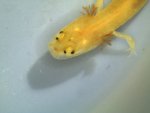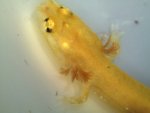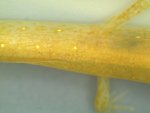Lamb
New member
- Joined
- Feb 28, 2009
- Messages
- 222
- Reaction score
- 12
- Points
- 0
- Age
- 35
- Location
- USA
- Country
- United States
Hello all!
I caught this little guy/gal earlier this morning in one of my study streams. It is an Eurycea cirrigera (southern two-lined salamander), and I'm wondering if there is a general term for this unusual color morph? The specimen, which is being raised in the lab, has xanthophores and iridiophores on its body, but no melanophores, except for those in the stripe within its irises. Ideas? I looked at the Axolotl page, and by the definitions there it might be a xanthic albino? But the melanin in its iris makes me doubt that.
I caught this little guy/gal earlier this morning in one of my study streams. It is an Eurycea cirrigera (southern two-lined salamander), and I'm wondering if there is a general term for this unusual color morph? The specimen, which is being raised in the lab, has xanthophores and iridiophores on its body, but no melanophores, except for those in the stripe within its irises. Ideas? I looked at the Axolotl page, and by the definitions there it might be a xanthic albino? But the melanin in its iris makes me doubt that.




